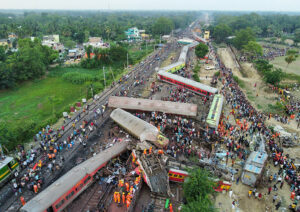BAHANAGA/NEW DELHI — An official probe into India’s rail crash is focusing on suspected manual bypassing of an automated signaling system that guides train movement — an action that investigators believe sent a packed express train into a stationary freight train, three Indian Railways sources told Reuters.
The Commission of Railway Safety (CRS) investigators suspect the bypass was done by railway workers to get around signaling hurdles that arose from a malfunctioning barrier used to stop road traffic at a nearby rail-road intersection, two of the three sources said.
The sources did not want to be identified as they are not authorized to speak to the media.
The June 2 crash at Bahanaga Bazar station, in the Balasore district of the eastern Indian state of Odisha, killed at least 288 people and injured more than 1,000. It was India’s worst rail crash in two decades.
Indian and international media have previously reported that a possible malfunction in the automated signaling system may have led to the crash.
However, details of the frequent malfunctions at the nearby rail-road barrier and its possible connection to a manual bypass of the signaling system are reported by Reuters for the first time.
The CRS, which is India’s rail safety authority, did not respond to a request for comment.
‘ERRATIC BARRIER’
Indian Railways, the fourth largest train network in the world, is a state monopoly run by the Railway Board. The board reports to the Railways Ministry.
A spokesman for Indian Railways said “repair works keep happening as per requirements” but tampering with the automated system is not allowed. He declined to elaborate further on the causes of the crash, saying: “the investigation is on”.
Amitabh Sharma, chief information officer at the Railways Ministry, said the cause of the accident was still under investigation. Asked about investigators’ suspicions that the electronic system may have been manually bypassed, Sharma said: “These are all speculations which we cannot confirm at this juncture.”
A spokesman for the federal police’s Central Bureau of Investigation (CBI), which has opened a separate probe into possible criminal negligence, did not respond to a request for comment.
Reuters spoke to five residents of Bahanaga village who said the barrier at the railway crossing had been faulty for nearly three months and had been repaired frequently.
When there was a fault, the barrier would remain stuck in the closed position and had to be manually opened by railway workers, the residents said.
If the barrier was open, the automated signal system would not allow a train to go past the rail-road crossing, one retired Indian Railways official said. The official did not want to be identified due to the sensitivity of the crash investigation.
“The electric barrier would sometimes go up and sometimes it wouldn’t,” said Soubhagya Ranjan Sarangi, 25, a pharmacist with a shop close to the railway crossing.
Niranjan Sarangi, a 66-year-old retired schoolteacher who spends many evenings sitting near the crossing with friends, was there at the time of the crash. He said the barrier seemed to be functioning fine at the time.
“The barrier would malfunction sometimes. People from the department would come and fix it,” he said.
SYSTEM ‘CHANGED MANUALLY’
One of the three Indian Railways sources — all of whom had knowledge of the ongoing CRS probe — said initial investigation suggests the automatic electronic signaling system was “changed manually, for which the software has to be tampered with”.
“(Indian) Railways believes the system was tampered with,” said the second source, who has access to briefings on the investigation. “It is yet to be ascertained whether the intervention was intentional or by mistake or whether due to ongoing work near the signal.”
The third source said the preliminary probe suggested that the signaling system was bypassed because the repair workers were trying to fix the malfunctioning barrier.
India’s rail network is undergoing a $30-billion transformation with gleaming new trains and modern stations under Prime Minister Narendra Modi’s push to boost infrastructure and connectivity.
The June 2 crash has raised questions about whether safety is getting enough attention. The government has said safety indicators have improved over the years, accident rates have fallen, and safety is getting adequate funds.
The crash happened when the Coromandel Express, heading to the southern city of Chennai from the eastern city of Kolkata, wrongly entered a sidetrack of the station at a speed of 128 kph (80 mph), and rammed into a stationary iron ore freight train.
The Coromandel Express jumped off the tracks and toppled after impact. Some of its coaches hit another express train passing on a parallel track in the opposite direction, causing that one to also jump off the tracks and result in a massive wreck.
Two days after the crash, Jaya Varma Sinha, a Railway Board member, told reporters that it appeared that the electronic signaling system, called the “interlocking system,” had sent the Coromandel Express on the wrong track by giving it a green signal.
The CRS findings now suggest that the system, which Sinha said is supposed to be “fail-safe,” had been compromised by workers trying to find a workaround, the third Indian Railways source said.
Sinha did not respond to a Reuters request for an update on the investigation.
Sandeep Mathur, Indian Railways’ principal executive director for signaling, the top official responsible for signaling, did not respond to Reuters requests for information about the supplier of the interlocking system.
Reuters could not independently establish the identity of the supplier or verify Sinha’s claim that it is fail-safe.
‘MANUAL INTERFERENCE NOT UNUSUAL’
The interlocking system coordinates between the signal, track route and track occupancy, and ensures they all work in tandem to take a train safely through a station, Mr. Mathur told reporters two days after the crash.
He did not respond to Reuters’ subsequent requests for more details.
The third railways source, as well as a retired railways official and a senior police officer who worked in the railway police in Odisha, told Reuters that railway workers sometimes manually interfere with the system to change the signal so that rail traffic is not slowed or stopped while they do any repair and maintenance work, especially on busy routes.
The retired official and the police officer did not want to be identified due to the sensitivity of the crash investigation.
The manual workaround is allowed under railway protocols if it is authorized by an empowered senior official and all precautions are in place, said Sudhanshu Mishra, another retired railway official who worked in the safety department.
The Indian Railways spokesman did not directly address the authorization issue and only said it is not allowed under Indian Railways rules.
Reuters could not independently determine if the suspected workaround on the evening of the crash was authorized or not.
A June 8 Railway Board circular on “safety of track” sent to all general managers of Indian Railways, seen by Reuters, said workers “should be counseled and guided for not adopting any shortcuts while carrying out the work”.
Controls of the interlocking system are located inside a small railway building at the Bahanaga Bazar station and access is restricted to authorized railways workers and officials.
The second source said records showed that the Bahanaga system control room had been accessed two times that evening, the first time for authorized operational work, while the reason for the second visit is yet to be established.
Reuters was unable to access those records.
All railway employees at the station, including those involved in the barrier repair work, have been questioned by the railways investigators and will also be questioned by the CBI, the second and the third source said.
They declined to name them as this is an ongoing investigation. Reuters could not independently establish how many workers are under investigation or their identities. — Reuters























